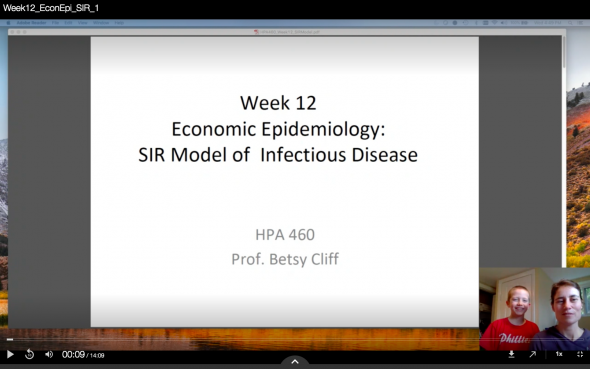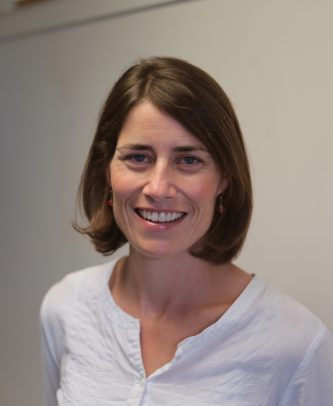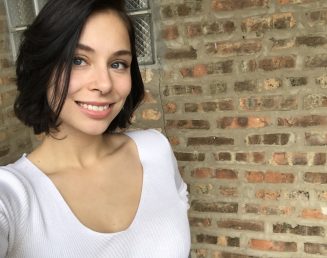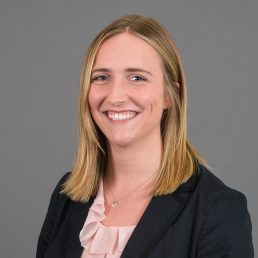Public health instructor shifts focus to make online course relevant to pandemic


While Betsy Cliff’s 400-level Health Economics class already was taught online before COVID-19 forced all education to go virtual, she quickly realized that history was in the making and decided to take advantage of this time as an instructor.
Cliff, who is an assistant professor of health policy and administration in the School of Public Health, used Blackboard email to give her students a voice in how they wanted the class to continue by asking them to fill out a poll.
“I asked if they wanted to continue with the course as scheduled, or swap out one week’s topics for a lesson on the field of economic epidemiology,” Cliff said. “They overwhelmingly voted to learn more about economic epidemiology, which has an immediate bearing on the spread of infectious disease.”
For Cliff, the challenge was to quickly pivot and prepare lessons on a topic she had not previously planned. As a health economist by training, she also had to hunker down and learn as much as possible about how economics could and is informing the current pandemic.
During her prep work, she was able to utilize textbooks on economic epidemiology, pre-peer review working papers and journalism that had done extensive epidemiological modeling. Ultimately, she put together about 30 minutes’ worth of lecture that she recorded on video for the online class.
At the same time that she was preparing lessons and videos, she also was dealing with the reality of being a sequestered mother of two young boys, Charlie, 10, and Gus, 8, whom she put to work.
“I tried to make the best of it by having my kids introduce some of the videos — it actually got really good feedback,” Cliff said. “They would say, ‘This is HPA 460 and this video lecture is about the SIR model.’ Then, they would move out of the way (they would usually run just off-camera, shake off their nerves) and I would continue with my lecture.”
Cliff said that the lessons also gave her sons an appreciation for her work. At one point, a video intro of a basic epidemiological model to predict the spread of contagious diseases led to her 10-year-old asking questions that required a fourth-grade version of a lesson on the topic.
“I talk to them about my work, and they know it’s important to me, but I think this actually gave them a little bit better understanding of how I do it,” Cliff said.
While that class was going on, Cliff also was team-teaching an in-person class with Stephanie Shapiro-Berkson on health care management, which was forced to move from the classroom to online. The content of that class did not change, but Cliff and Shapiro-Berkson had to take one of the school’s largest classes to an all-online format, something they had not even considered at the beginning of the semester.

Anthea Abers, who just finished her first year working on her master’s in public health, said that while the transition online in her IHPS 403 class was abrupt, she praised her teachers’ ability to create a structure with the online lecture videos. They did so by helping mediate the videos by introducing major themes, referencing how they would be broken down and pointing out assignments, Abers said.
“I also loved that she included her kids in introducing the themes because I think it helped to feel like we were still sharing a little of our lives together as a class and was a good reminder that so many of us are trying to learn, teach, work in environments that are shared with our children and partners,” Abers said.
While Mary Cleary, who is a first-year student working on her master’s in public health, prefers in-class lectures and learning, she felt her teachers were very responsive via email, virtual office hours and calls.

Both Cleary and Abers said that while they did not choose an online class, a positive trade-off was that they enjoyed the flexibility of virtual learning.
“I know many of us are juggling family life, careers, responsibilities and general uncertainty, so I appreciated the professors recognized that and responded accordingly,” Cleary said. “Ultimately, I am glad that they maintained a high expectation for our performance.”
In addition, students appreciated that a final project that initially required both an in-class presentation and a written report was changed to allow students to choose one or the other, which allowed them to “produce a higher quality end product,” Cleary said.
“It is hopeful to me that the majority of my professors went above and beyond and offered increased support, understanding, resources and humanity during this time — when they, no doubt, deal with many of the same challenges us students face,” Abers said. “I am hopeful that equity will continue to be the focus of UIC’s response and adaptation during this crisis, and beyond it. Health, safety and support are critical underpinnings to learning — now and always. I am grateful this is being recognized, and I’m proud to be a student of public health here at UIC.”
